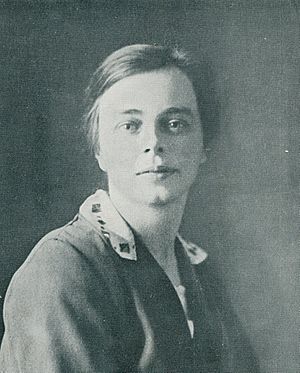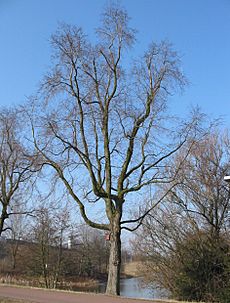Christine Buisman facts for kids
Quick facts for kids
Christine Buisman
|
|
|---|---|
 |
|
| Born |
Christine Johanna Buisman
22 March 1900 |
| Died | 27 March 1936 (aged 36) Amsterdam, Netherlands
|
| Resting place | Westerveld Cemetery, Driehuis, Netherlands |
| Occupation | Phytopathologist |
| Years active | 1926–1936 |
Christine Johanna Buisman (born March 22, 1900 – died March 27, 1936) was a Dutch scientist who studied plant diseases. She spent her short career researching Dutch elm disease. She also worked to find elm trees that could resist the disease.
In 1927, Christine Buisman proved that a fungus called Graphium ulmi (now known as Ophiostoma ulmi) caused Dutch elm disease. This discovery ended a big debate among scientists that had been going on since 1922.
Buisman also created a special way to test many elm plants quickly to see if they were resistant. In 1932, she found another form of the fungus, which she named Ceratostomella ulmi. After she passed away, the first elm tree that could resist the disease was named 'Christine Buisman' in her honor in 1937.
Contents
About Christine Buisman
Christine Buisman was the oldest of four children. She grew up in Leeuwarden, a city in the Netherlands. Her family believed in being open-minded and helping others.
She finished high school in 1919. Then, she went on to study Biology in Amsterdam. At first, she was most interested in plants that grew in the ocean.
From 1923 to 1924, Christine took special courses at a plant disease lab called "Willie Commelin Scholten" in Baarn. This lab was located next to another important center for fungi, where she also worked as an assistant. Both places were led by Professor Johanna Westerdijk. Professor Westerdijk was the first female professor in the Netherlands, starting in 1917.
In 1927, Christine Buisman earned her doctorate degree from Utrecht University. Her research was about fungi that cause root rot in plants.
Researching Elm Tree Disease
In late 1926, Christine Buisman received money to study Dutch elm disease further. She was put in charge of this two-year project. A part of the lab's garden was planted with young elm trees for her experiments.
To infect so many plants, Christine tried using a syringe. This method became very useful for many years after. In 1927, she successfully made the trees show signs of the disease, like discolored wood and wilting leaves. She did this by infecting the plants earlier in the summer than previous researchers. Her work confirmed that Graphium ulmi was indeed the cause of Dutch elm disease.
In 1929, Buisman traveled to Berlin, Germany, for more studies. That August, she went to a meeting in Geneva, Switzerland. There, she met Bernice Cronkhite, a dean from Harvard University in the US. Christine saw this as a chance to apply for a scholarship to study elm trees and their diseases in the US.
By the next month, she began her one-year study in Boston. Her main goal was to find out if Graphium ulmi was also in the US. Just before she returned to Europe, she finally found the fungus in samples from Cleveland. She was the first person to confirm the fungus was present in North America.
She also studied other elm tree diseases. She received help from the United States Department of Agriculture, which donated young elm trees. She wrote about her findings in a scientific paper published in 1931.
The Dutch Elm Committee
While Christine Buisman was in the US, people in the Netherlands started to take the threat of Dutch elm disease more seriously. In February 1930, a new group was formed called the Committee for Study and Control of the Elm Disease.
Professor Westerdijk asked Christine to come back and work as a researcher at Baarn. Christine returned in October 1930. During her time there, she wrote many articles about elm disease. She also gave speeches in the Netherlands and other countries, as she spoke several languages. She quickly became known as the top expert on elm trees in Europe.
By 1935, Christine had tested thousands of young elm trees. She chose several promising ones that showed much better resistance to the disease. Two of these were from France and Spain. She planned to use them for breeding new, stronger elm trees. She worked with Simeon Gottfried Albert Doorenbos, who was in charge of the parks in The Hague.
Her Passing
In March 1936, Christine Buisman had an operation. Although it seemed successful at first, she became ill from an infection and passed away on March 27. This was just five days after her 36th birthday. She was buried three days later at Westerveld Cemetery in Driehuis, near the North Sea.
Named in Her Honor
In 1937, the Dutch Elm Committee decided to release one of the resistant elm trees she had found. They named it 'Christine Buisman' to honor her hard work.
Even though the 'Christine Buisman' elm didn't grow exactly as expected and could get another fungus, many old trees still stand today. You can find them in the Netherlands, England, and the US. They are a lasting reminder of her important achievements.
What Happened Next
The project to breed resistant elm trees in the Netherlands continued until 1992. Later, similar projects started in North America, Italy, and Spain. These projects have released many more elm trees that can resist Dutch elm disease.
Christine Buisman Foundation
Soon after Christine's death, her parents created the Christine Buisman Foundation. This foundation helps pay for Dutch female biology students to study in other countries.
See also
 In Spanish: Christine Johanna Buisman para niños
In Spanish: Christine Johanna Buisman para niños


